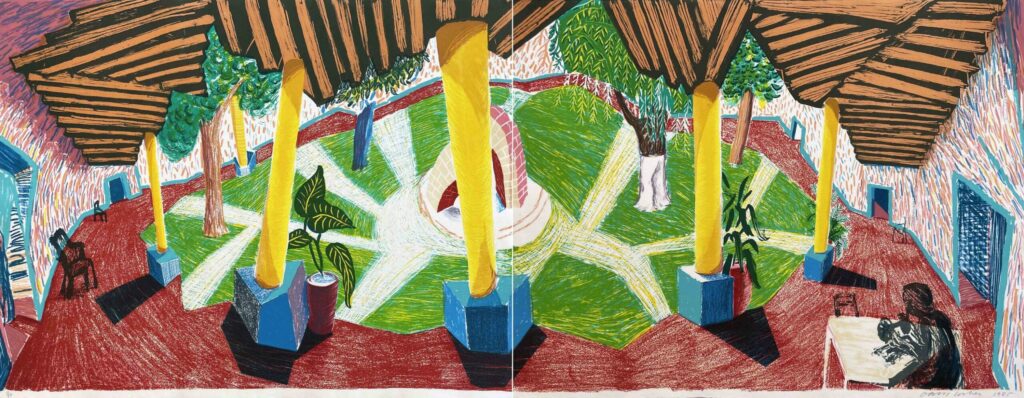David Hockney Art Prints
David Hockney adopted printmaking much earlier than many of his contemporaries, making his first print in 1954 while still a student at Bradford School of Art. During his time at the Royal College of Art (1959–1962), he became quite passionate about printmaking. When Hockney couldn’t afford painting supplies, he developed the practise of hiding out in the college’s studio after learning that the supplies in the print department were free. David Hockney art prints have evolved alongside his paintings and drawings as he continued to create and experiment with a variety of techniques and technologies throughout his lifetime, including etchings, lithographs, screenprints, paper pulp works, photocopies, faxes, and iPad drawings.

In the 1960s, Hockney began taking his etching, the first of his two primary printmaking methods (the second being lithography), seriously. When he committed more than a year of his life to his second major print project, Illustrations for Six Fairy Tales from the Brothers Grimm, it became clear that he loved this medium. Between September 1968 and November 1969, Hockney put his painting on hold to journey along the Rhine, researching all known illustrated Grimm fairy tales, taking photos and making drawings of his surroundings for inspiration, and reading all 239 tales. He picked the stories for the series based on how he would illustrate them and preferred etching because it suited his creative approach the best.
Hockney adopted lithography as a substitute for etching in 1965 and continued to employ the technique as his primary printmaking medium into the 1970s and 1980s, working alongside master printmaker Kenneth Tyler in all four of his studios. Hockney adapted to lithography easily because to its painterly use and Tyler’s adaptable working methods. He was able to use the technique to explore his passion for Japanese art, leading to the 1973 creation of his well-known Weather series. Hockney was working on the idea of capturing the weather, and the stylised qualities of Japanese woodblock prints served as inspiration. This is demonstrated in Lot 18, Snow, where Hockney employed tonal gradation to express a particular recession. Hockney remarked on the undertaking, “Getting back into lithography is wonderful. Everything you put on a stone actually shows up. The first four are almost done. I’ve done four so far: rain, mist, sun, and lightning; I still intend to paint four more: snow, frost, wind, and a rainbow.”

Again collaborating with Kenneth Tyler in 1984–1985, Hockney gave in to his obsession with space and perspective to investigate how it was represented on paper while working on the more than 25 lithographs produced for the artist’s Moving Focus series—his greatest and most ambitious series. The collection contains colourful and textured interior views, chairs, views of a Mexican hotel, and portraits in homage to Picasso’s impact and his studies of Cubism. In order to arrange an image’s colour alignment, Hockney and Tyler developed a novel printing technique for this series that included layering transparent mylar sheets.

Hockney adopted not only the techniques offered to him by conventional printers but also those being freshly developed through advancements in the consumer market because he was an artist with a keen interest in new technology. After making his first foray into photography in the early 1980s, Hockney started a project in 1995 where he took pictures of his own creations at his studio. Hockney created works with an air of performance by setting paintings in progress under various theatrical lights, painting the canvas’s borders further, and occasionally adding accessories to these “shows.” The most well-known of these is Snails Space.
Hockney bought one of the first iPads when they were initially released in 2010. Having tried drawing on an iPhone before, he was eager to use the new gadget.

Hockney hailed the freedom of the iPad and compared modern artists’ use of technology to the Renaissance painters’ use of mirrors, taking use of the capacity to go back and edit several “layers” [sic] of a drawing.
Hockney has consistently demonstrated his capacity as a printmaker with a wide range of capabilities and evolution by responding to new printing possibilities and technology, such as the etching, inkjet printer, and iPad. The artist has had the chance to explore new themes and refine his thought processes alongside the development of each new printing technology. Hockney has established himself as one of the most prolific and technically daring artists throughout the course of his 60-year career, much like Picasso.
View available David Hockney art prints here.
